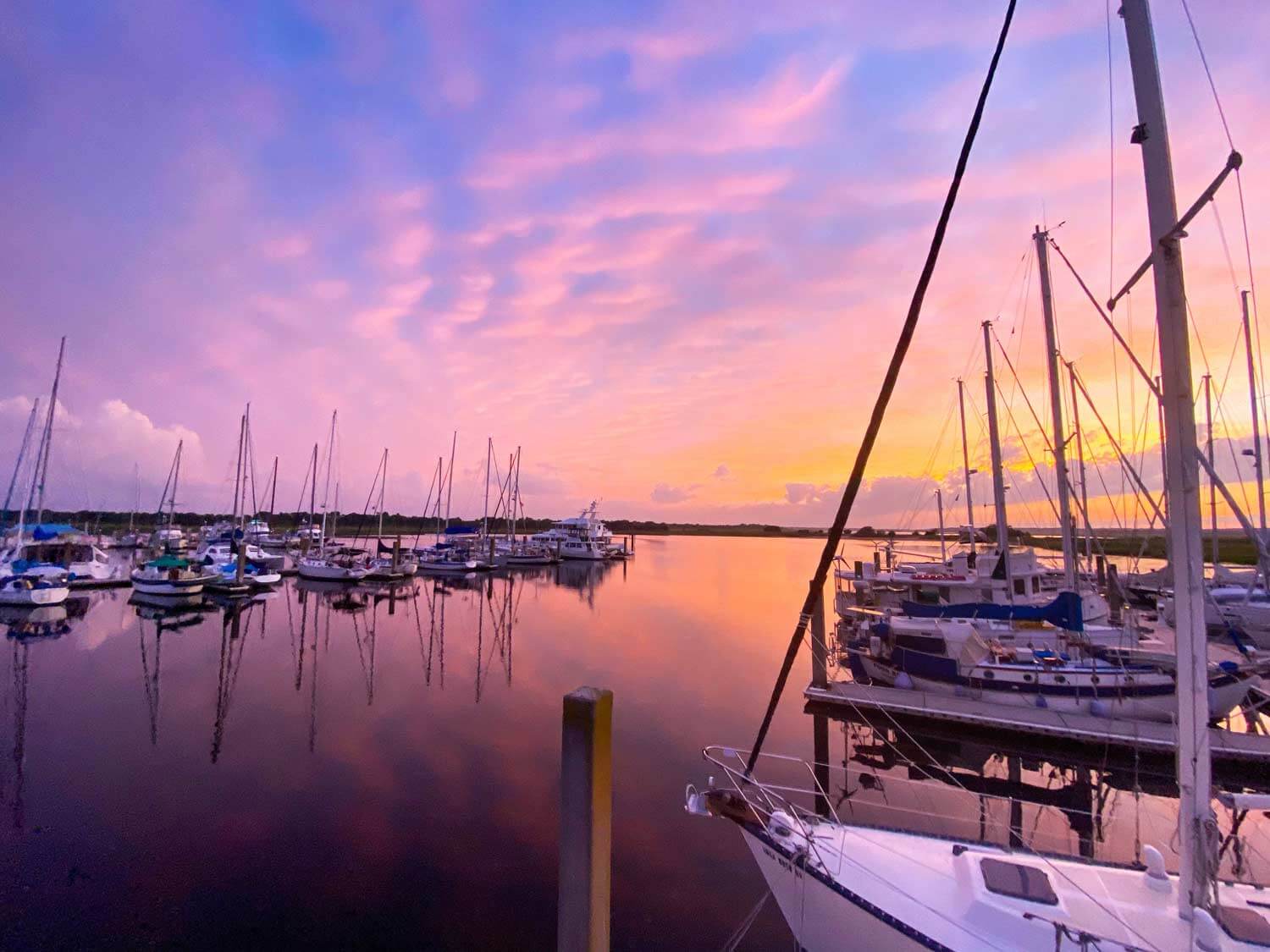Living on a Boat Full Time: What to Expect as a Liveaboard Cruiser
As an Amazon Associate, we earn from qualifying purchases. We also earn from other affiliate websites. See our full disclaimer.

12 Things I Wish I Knew Before Moving Aboard
Before moving onboard, there were a lot of things I thought I knew about living on a boat full-time. Despite my research, I was only scratching the surface of what it’s like to live this lifestyle.
From the weather’s impacts to route planning and provisioning – traveling on the water is different.
After two years of living on a boat full-time, here are a few things I wish I had known before moving aboard.
1. There will always be things to fix.
You hear this all the time when talking to anyone about life on a boat. No matter what type of boat you have, it will need constant upkeep. When one thing gets fixed, three more will break.

Like many first-time boat owners, we heard this over and over. Of course, it doesn’t hit home until you see the survey that details every last inch of issues. Or when you start living aboard a boat and experience first-hand the deterioration in a marine environment.
The good news is you can become a master of prioritizing your boat project to-do list.
- Consider essential things versus cosmetic projects.
- Look at safety versus nice-to-have updates.
- Weight the time it takes to fix something versus the maintenance costs of it hiring out to a contractor or boat yard.
You can learn to improvise and create workarounds when you need to, and most boat owners ultimately become handy out of necessity. Over time you’ll recognize the importance of having a safe, operational vessel.
Oh, and when you finally fix the broken igniter on the oven after two years, it will be that much more rewarding.
Some of the best advice you’ll receive is this – if you try and fix it all, you will never leave the boat dock.
So, find the strength to accept the five-page to-do list and get out there and enjoy your boat. That’s what all boat owners are out there trying to do!
READ NEXT: Check out our list of what you need in your sailboat tool kit.
2. Living on a boat is like camping.
Even on a bigger boat with more than the average amenities – once you are out of the marina, living aboard is a lot like camping.

You are at the mercy of the weather when underway or on anchor. You have limited resources, no air conditioning, and access to grocery stores or other supplies is usually out of reach. On the flip side, you have the ability to visit remote islands and other exotic places and immerse yourself in the beauty around you.
In the woods and on the water, you think about things like navigation, water supply, and provisions.
Both activities give you a sense of independence and teach you about survival in nature. You can get by without the most modern conveniences and with a minimalist approach to living (although you will probably want some creature comforts).
Do you enjoy the logistics and planning, as well as the communing with nature that camping offers? You might also like the challenges and rewards of living on a boat.
3. You need to be diligent with cleaning.
Living in a marine environment requires a substantial commitment to cleaning.
Before living aboard, I remember thinking – cleaning will be a breeze in such a small living space.

Well, not really. Yes, it’s smaller, so tidying is quicker. But putting things in their place can sometimes be a challenge. Storing items with the marine environment in mind requires extra steps. Sometimes getting into storage areas is also inconvenient.
The key to keeping your boat tidy is storing the most often used items in places that are accessible.
Where cleaning is concerned, the marine environment creates obstacles different from land living.
Mold grows fast – even faster when the temperature drops and condensation is an issue.
Dirt comes in from every hatch and door that’s open. If you’re on a catamaran, dirt enters through a dozen hatches and a large cockpit door that’s usually open.
There’s also a load of areas that need special attention to keep clean.
- the boat bottom
- dinghy
- bilges
- ground tackle
- outside of the boat and the gel coat
- fresh water tanks and black tanks
- teak
- stainless steel
These areas are continuously affected by everything from corrosion to marine bottom growth. They need specific cleaning products and techniques to keep them in ship shape.
Besides your own research, ask around for helpful tips from fellow boaters. This will save you extra work and help you avoid surprises in the future.
4. It takes time to learn the boating world.
Learning to sail, maintain a boat, and live on a boat is not something you learn in a week or even a few months.

Some cruisers say it takes around three years to find your groove within the liveaboard lifestyle.
When you move aboard your first boat, you are pretty much learning a new way to live. Especially if you are jumping in with little previous boating experience.
All the boating things take time to master. Besides learning how to operate your boat, you have to learn how to live on it. Including but not limited to the below.
- weather
- tides
- navigating and route planning
- sailing
- anchoring and docking
- radio communication
- regular maintenance (diesel engines, plumbing, electrical, etc.)
- resource management (water, power, fuel)
- provisioning
- cooking
In each of these areas, there are things we are still working on. It takes time to develop skills. And in some cases, it takes a lot of experience in many different locations.
Learning these new skills is both challenging and exciting. It can also be a little scary. You are pushing yourself out of your comfort zone at every turn.
When you make a mistake, consider it one of many future valuable cruising lessons.
When you succeed, celebrate! Even the smallest victories are worthy of a sundowner toast when you live on the water.
5. You don’t need a big wardrobe onboard.
When I was planning to live aboard, a big project was downsizing my wardrobe. I prepared to cut my wardrobe down to about 20% while being meticulous in choosing what to bring on the boat.

I got rid of tons of clothes and only brought a small fraction of my previous wardrobe aboard. But I didn’t need even half of it.
Seriously, you don’t need many clothes on a boat. You just need the right clothes.
Determine a few types of comfortable items appropriate for the climate you intend to live or cruise – then you’re set. Once you find your “boat uniform,” you’ll wear it every day.
Sure, you’ll want things for the occasional night out or shore excursion. But a couple of mix and match pieces will do. And very casual is usually sufficient for the average cruiser. I find I have way too many dressier items (which aren’t even that dressy.)
Here are a few clothing items that I kept that I shouldn’t have:
- casual clothing (shorts and tops) that are 100% cotton
- more than one dress or other formal clothing
- any leather
- more than one pair of jeans
- more than 4 or 5 swimsuits (find a few you love and ditch the rest)
- bulky sweatshirts
- more than 1 or 2 quality sun hats
With any good minimalist wardrobe, layering is essential. Identify items that are flexible enough to wear alone or under other things.
The capsule wardrobe concept is also a good idea on a boat. Research strategies behind these wardrobes and apply them to your closet on the water.
READ NEXT: Find more info in our guide for how to downsize your wardrobe and our post on what to wear sailing.
6. Start living like you’re on a boat before life aboard.
As a liveaboard, certain habits will make life in your floating home easier.

Developing routines to save water and practice sustainability are easier to tackle while you’re still enjoying land life.
Learning to cook things from scratch and testing new personal care regimes will save you time and stress.
Here are some things I wish I had started doing while still land-based.
- making pizza dough, bread, and bagels
- making yogurt
- making vegetable broth
- learning to fillet a fish
- provisioning (experimenting with dried and canned foods)
- adjusting personal care regimes (hair and make-up products, menstrual products, etc.)
- washing dishes with less water
- showering with less water
- minimizing laundry
- minimizing trash
Once you start cruising, you’ll have your hands’ full learning all the new boat things.
The more “boat life” habits you can instill before moving aboard, the more manageable your new lifestyle will be.
7. You’ll cook differently in the boat galley.
Before boat living, I would follow recipes to the exact ingredient. I wasn’t much for deviating from the formula. Then I moved on a boat where you rarely have precisely what the recipe calls for.

When you start cooking on a boat, you will begin to find replacements or substitutes out of necessity. Maybe you don’t have room for fresh bell pepper in the fridge, so you opt to keep roasted bell pepper in a jar. Or you learn that having dehydrated milk is more efficient for cooking.
The canned goods aisle will become an area you explore the most on your journey to master the boat galley.
I never purchased canned mushrooms in my land-living days. Now, I keep a stockpile. Also, canned potatoes, anyone?
The more you cook, the more experimental you’ll become. When you travel to new places, you can find items at the local farmers’ market and give them a try too.
You’ll also discover that certain types of food are more comfortable to cook on a boat. I never cooked much Asian food on land but started experimenting with stir fry, curries, and homemade ramen onboard. Carrots and onions keep well, and you can throw just about anything in a stir fry.
We enjoyed the process of learning what works for cooking onboard. It’s also fun to start mastering things from scratch, such as homemade bread, pizza dough, yogurt, and broth.
READ NEXT: You might also want to check out our list of 7 easy and versatile meals on a boat or our 5 ideas for a delicious breakfast on a boat.
8. You will want to throw your partner overboard.
When cruising with a partner, most of us have reached a point where you drive each other nuts.

The truth is living on a boat can be very stressful at times. And all the stressors tend to rear their heads at once. Add that to the fact you’re in a tiny, challenging living space, and tempers get short.
When we start to get at each other’s throats, we try to acknowledge it early and adjust. Sometimes just saying we are on edge and talking it through will help. Other times we need a break off the boat to find our composure and regain our patience.
Having a schedule adds to the pressure. The more you can cruise at your comfortable pace, the more likely you will not murder your partner!
The living situation on a boat will test your relationship. Take the time to talk about the triggers and maybe buy a set of “marriage savers” for anchoring and docking.
9. You need to be flexible.
A well-known sailing adage is, plans are written in the sand at low tide.

If you don’t do well with last-minute changes, you might not love this lifestyle.
Your plans will frequently change living on the water. Then they’ll change again and switch back. Sometimes we’ll change our route two or three times on the morning of departure.
Everything fluctuates based on weather, routing issues, boat issues, and plain bad luck. You may need to avoid a storm, pick up a spare part, or dock in a liveaboard marina for the season to take care of a health issue.
Traveling on the water, you’ll get more familiar with the idea of having a plan A, B, C, and sometimes even D.
Having many options is a way of planning while acknowledging you are in a fluid situation on a boat.
As you gain more experience, it will become more natural to accept changes. You might even find you’re immediately onto the next step when you hit an obstacle in your current plan.
A positive spin to this aspect of the lifestyle is you often end up in unexpected places. And sometimes, that’s not a bad thing. If you can roll with the punches, you’ll find appreciation in even the most unlikely plans.
10. Full-time cruising is a full-time job.
When you start cruising, friends and family might ask what you do all day. You’ll find this amusing. Because when you’re actively cruising, moving the boat regularly to new locations, THAT is what you are doing.

Cruising on a boat is a full-time job and hard work. It includes route planning, watching the weather, performing maintenance, provisioning, managing resources, and more. Not to mention taking your shift at the helm. You are never without things to do, especially if you are living primarily on the anchor or a mooring ball.
You’ll often find you have to tell yourself to put boat chores on hold and enjoy the benefits of the lifestyle.
Although cruising is a lot of work, the good news is you are the boss. So when you find yourself worn out or short-tempered, consider giving yourself a break.
Slow down, and throw the timeline out the window. The best thing about this lifestyle is about the journey as much as the destination.
11. The cost of living can be high.
Even on a small boat, cruising and boat expenses can get out of control quickly if you don’t stick to a budget.

Boatyards and maintenance costs, liveaboard slip fees, boat insurance, and more will empty your bank account or boat cruising kitty. If you work from your boat, you may also need to spring for high-speed internet access so you can work from remote locations (Starlink has recently become more popular in the boating community).
Depending on where you’re cruising, food costs and other everyday items can also be very expensive.
If you’re thinking about living on a boat, do your research on the location you’ll be cruising in, whether it’s the east coast of the United States or the south pacific, and find the average costs of liveaboard marinas and boat insurance to cruise in that area.
Also, be aware that the insurance premium may cost more in certain areas, especially during the official hurricane or cyclone season (if the insurance policy even allows you to stay in the area).
READ NEXT: Read our full guide on the cost of living on a sailboat.
12. Living aboard can be uncomfortable.
Whether you’re out in open water or anchored near a bay, bad weather will find you.

High winds can bring rough seas, and this can make being on a boat very uncomfortable, both physically and mentally. However, the more boating or sailing experience you gain, the more confident you’ll be in these situations.
The reality is you can only plan so well for weather on liveaboard boats, and a lot of the time, you just need to be prepared for what mother nature throws at you. Most boaters will err on the side of caution when it comes to route planning for incoming storms and choosing to lay out more than less anchor chain!
Living on a Boat Full-Time: Is it Worth it?
If you are transitioning from a modern way of life, living on a boat will shake up your lifestyle. It’s an adventure that is entirely different from living on land.

My vision of what it would be like living on a boat and actually living on a boat are a far cry from each other. But nothing is ever as you imagine it.
If you’re up for the challenges, living on the water can be a unique and fulfilling lifestyle. From the skills you acquire to the places you visit and the people you meet – there’s no doubt cruising on a boat is a once-in-a-lifetime experience.
Want to learn more about cruising full-time on a boat?
For more on finding the right boat, the cost of cruising, and learning how to live on the water, view our complete guide.
Like this post? Save it on Pinterest for later.

Or view our web stories.




